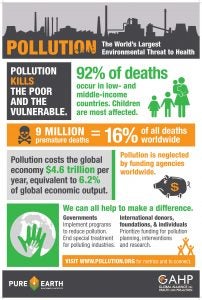Pollution is responsible for 9 million deaths globally: Two-thirds are due to air pollution
Dr. Ananya Roy is a Health Scientist
Over the last few weeks as forest fires engulfed large areas of California, air quality in the Bay area plummeted. Doctors and pediatricians were on high alert to deal with the health impacts felt most acutely by children and the elderly. Pediatrician’s offices had phone messages that said “If you are concerned about air pollution and calling to make an appointment for your child’s asthma please dial …” and advised citizens to use face masks and air purifiers and stay indoors. News outlets compared air pollution levels there to winter days in Beijing or New Delhi where air pollution is a more consistent threat. These fires drive home the reality of the effect of pollution on health.
Time and time again pollution related news from across the country and globe have made headlines, ranging from lead and PFOAS in water Flint and Hoosick Falls, benzene in Houston, to the “Airpocalypse” in Beijing and New Delhi. Though these articles highlight the disastrous effects of pollution from major pollution and weather events, the constant and ongoing silent impact of air pollution on the lives of children and communities remains underappreciated.

Today, the Lancet Commission on Pollution and Health, an initiative of The Lancet, the Global Alliance on Health and Pollution (GAHP), Pure Earth, and the Icahn School of Medicine at Mount Sinai, with additional coordination and input from United Nations Environment, United Nations Industrial Development Organization (UNIDO), the World Bank, and others provide the first comprehensive global analysis of the health and economic impacts from all forms of pollution (air, water, soil, occupational). My colleague Elena Craft and I were contributors to this report.
The analysis carried out through the Global Burden of Disease framework estimated that pollution across air, water, soil, and occupational exposures costs the global economy $4.6 trillion per year, approximately 6.2% of global GDP, and resulted in 9 million deaths in 2015. This is equivalent to 16% of all deaths worldwide. Three times more deaths than AIDS, tuberculosis, and malaria combined; and fifteen times more than all wars and other forms of violence.
Of the 9 million deaths, air pollution accounts for 6 million deaths. The remaining 3 million deaths is a woeful underrepresentation of the true burden pollution has on communities. This is because of the lack of data on levels of exposures to known toxicants like mercury, asbestos, and contaminated sites in areas where there is unregulated recycling, mining, industrial activity, or a legacy of known and unknown chemical spills. Further unquantified is the wide spread use/ exposure to chemicals and their health effects.
Pollution affects the most vulnerable. It is intrinsically linked to poverty and development- nearly 92% of pollution-related deaths occur in low- and middle-income countries. More than 50% of air pollution related deaths take place in India and China. Even within countries, pollution’s toll is greatest in poor and marginalized communities. A recent study reports that in 2010, black and Hispanic people in America had 37% higher exposures to air pollution than whites and face more severe health effects due to air pollution. Children face the highest risks because small exposures to air pollution and chemicals in utero and in early childhood can result in lifelong disease and disability, premature death, as well as reduced learning and earning potential. This has an impact on the future generation’s productivity, in addition to downstream effects on equitable economic development in countries battling disparities in health and poverty.
Despite the enormous impact of pollution on health and the interconnection with development, it remains an underfunded issue. The political will to deal with pollution is overshadowed by the perceived trade off with economic development.
Globally, however, there are new shifts in willingness to address pollution. Just this week Xi Jinping, China’s president, emphasized the move toward green development and the importance of the environment. Countries such as China and India and cities like Paris and London are making commitments to ban the sale of gasoline cars and switch to electric vehicles within the next 10 to 15 years. The health benefits of this is only going to be realized, however, if the electric power generation utilizes more renewable sources of energy. This is already happening as countries move away from coal for electricity generation.
However, here in the US, our current administration is rolling back environmental protections. Earlier this month, Scott Pruitt, issued a proposed rule that would repeal the Clean Power Plan outright. Also being reviewed are vehicle emission standards. All this is being done in the guise of promoting the economy and jobs, even as 90,000 Americans die each year due to air pollution alone. EPA’s own analyses show that reducing pollution and growing the economy at the same time is possible, since 1980 air pollution has gone down 65% while the economy has grown by more than 153%.
This report is a reminder that pollution has very real health and economic impacts. Our leaders have a responsibility to protect the health of the people and we need to hold them accountable.












